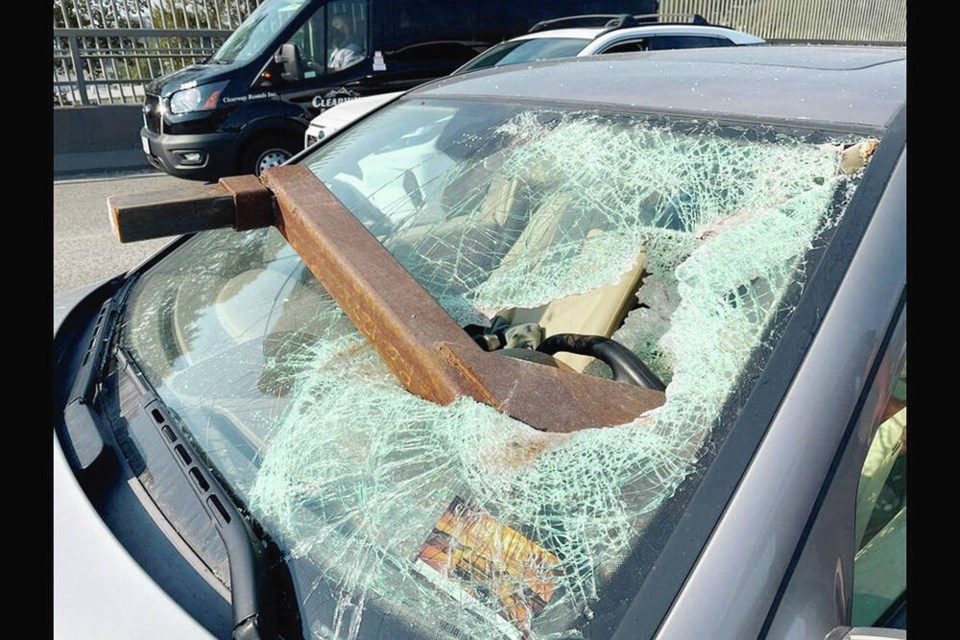I always try to pack facts and statistics into this column without turning it into a research paper capable of curing any form of insomnia.
But there are times where no amount of data or factoids can explain what happened in a car crash. More importantly, how do some car drivers survive the most horrible seconds in their lives?
I can’t explain it. I don’t think it’s possible. So just read them and like me just go: “Wow.”
A couple of weeks ago, Susan Milne of Squamish was driving across the Ironworkers Memorial Bridge in Vancouver, taking her four-year-old son to an appointment. The young man was buckled in his car seat securely on the rear passenger side of their car.
That itself was an act of immense fortune, because near the middle of the bridge a large truck heading in the opposite direction lost some of its load. Part of that load included a huge piece of angled steel that bounced up from the roadway, over the concrete centre divider, and with missile-like velocity pierced Milne’s front windshield.
The force of the impact bent her steering wheel like a pretzel, as the beam lanced past her left shoulder and stopped just centimetres before it would have impaled itself in the rear seat.
During media interviews Milne’s only visible injury was a three- to four-centimetre hole in the shoulder of her left shirt sleeve, torn open as the beam passed by her. Yeah. That close.
This column is about a few miracle survivors, but let’s pause here for a second and offer up another reminder about the importance of securing your loads no matter what type of vehicle you drive.
Last October, Tyler Fehr, 30, of Williams Lake and his dog were driving on Soda Creek Road when his truck hit a soft spot on the shoulder.
The truck left the road, rolling several times as it plummeted more than 30 metres down the embankment.
Fehr ended up with broken ribs, a compression fracture to his lower spine, a herniated disc, torn muscles, cardiac and pulmonary contusions, a broken nose and a cut that sliced open most of his forehead.
This one was a double miracle. After regaining consciousness about an hour later, Fehr, despite these life-altering injuries, managed to climb back up the embankment. That took him five hours. Finally reaching the top, he passed out again in the middle of the road, but eventually came to and flagged down help.
Alpine, his St. Bernard dog, who was thrown out of the truck, walked away as well with just a limp.
Finally, back on Christmas Eve 2019, a 61-year-old woman was driving on Highway 3 about 30 kilometres outside of Princeton when her car left the road and plunged 20 metres down an embankment toward the Similkameen River.
The vehicle flew off a ridge at one point, sailed into the air and hit a tree about five metres above the ground before it crashed beside a large boulder.
Witnesses say the car looked like a crushed pop can. Yet the woman managed to crawl out and was laughing and joking about the whole thing in her hospital bed a few hours later. Her injuries were minor.
When you’re driving, some things, such as flying metal bars, are completely beyond your control. What is in your control is the effort to give 100% of your attention to the road when you’re out there.
I get it that 100% focus, all of the time, is impossible of course.
But by maintaining alertness, driving prudently for road and traffic conditions and wearing your seatbelt, your chances of avoiding death or serious injury increase dramatically.
While these incidents show that miracles do happen, you never want to be the driver that keeps on proving that.
Glove Box: Colin emailed last week about how Nanaimo has come up with a better idea about letting drivers know where a school zone ends. They decided to place smaller “pentagonal” signs on the back of the regular school zone sign which are very cleverly marked: “School Zone Ends”.
Great idea. This would certainly help with that whopping 74% of respondents to that recent BCAA survey who said they couldn’t figure out where a school zone actually ends.



